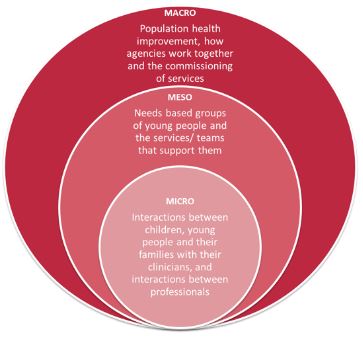The National i-THRIVE Programme recognises that delivering improved outcomes to children and young people’s mental health and wellbeing requires consideration of the role of implementation across the system as a whole.
Working across the system
Moving towards a ‘THRIVE-like’ way of delivering services for children and young people requires engagement in change across the whole system that supports them. This includes traditional health services (e.g. CAMHS), social care, local authority, education, key voluntary sector services and other independent organisations that may contribute to supporting children and young people’s mental health and wellbeing.

Working within the different levels of the system
In addition to looking across the system, it is equally important to think about the different agencies/services/organisations within the system at the three different levels; the ‘Macro’, ‘Meso’ and ‘Micro’ levels. At each level you can talk about 1) the children, young people and families and 2) the available support.

The ‘Macro’ level (or strategic/organisational level):
Children, young people and families: The population health outcomes for children, young people and families locally.
Available support: The way in which services are commissioned to meet the needs of local children, young people and families and how different agencies within the system work together to support them.
The ‘Meso’ level (or service level):
Children, young people and families: The outcomes of the groups of children, young people and families who are grouped according to their needs for care, as described by THRIVE Framework’s five needs based groupings of: Thriving, Getting Advice and Signposting, Getting Help, Getting More Help and Getting Risk Support.
Available support: The different services that support children, young people and families who are considered to be in one of the five needs based groupings.
The ‘Micro’ level (or individual level):
Children, young people and families: The outcomes of children, young people and families.
Available support: The interactions between staff within and across services supporting children, young people and their families. The interactions children, young people and families have with their clinicians/support workers/case holders.

Implementing the THRIVE Framework will require thought about how to effectively engage and work with the whole system of local services for children and young people’s mental health and thought about how to involve service users and people working at all three levels, from commissioners to clinicians. The i-THRIVE Toolkit provides guidance on how this may be achieved.